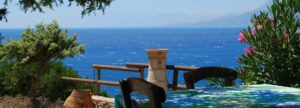Crete is the largest of the Greek islands and the fifth largest in the Mediterranean after Cyprus, Sicily, Sardinia and Corsica. It is 12 to 60 km wide, 260 km long and occupies an area of 8.259 km², on which around 500.000 people live. Located at 35 degrees north latitude, Crete juts further south than Tunis. The coast length is 1.046 km.
The island is made of limestone and is dominated by large mountains. The "white mountains" in the west reach 2.452 m, the Ida mountains in Central Crete 2.456 m, the Dikti mountains in the east 2.148 m. The mountains are criss-crossed by numerous deeply cut gorges, the most famous of which is the 18 km long Samaria Gorge. It connects the 1.150 m high Omalos plain with the south coast.
On Crete, an island with many contrasts, evidence of four thousand years of past alternates with modern concrete skeleton buildings and small villages untouched by tourism lie next to modern tourist centers.
Its inhabitants are as contradictory as the landscape of Crete. They are farmers who still go to sea today or shepherds who have become hoteliers or farm workers who have become city dwellers. What they all have in common, however, is that they are generous and open-minded towards all tourism and, of course, the guests of their homeland, that they cling to the old traditions and that they have an overwhelming hospitality.
Contrary to popular belief in our latitudes, the island lives not only from tourism, but also from agriculture and sheep and goat breeding. The fertile plains between the mountains or in the coastal region are used intensively for agriculture. Open extensions alternate with greenhouses and orchards with extensive vegetable fields. The fresh green of the vines shines on the flat slopes and the olive trees shine everywhere.
The high mountains are covered with snow until spring and form a delightful contrast to the blue sea and blooming nature. Rainfalls are heavy but very rare and the sun shines up to 300 days a year.






